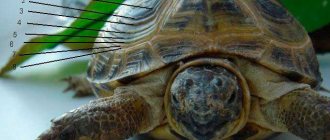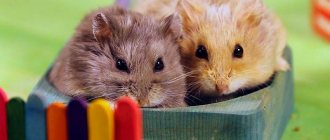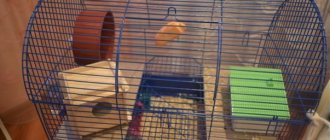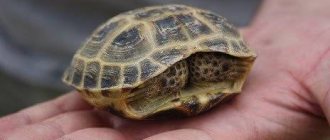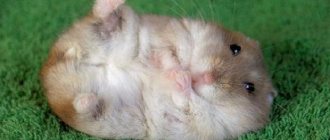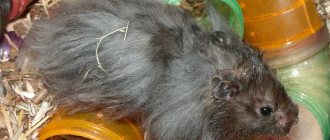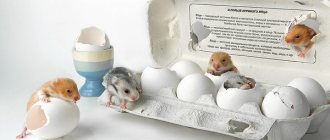What determines the lifespan of hamsters?
Life expectancy is a multifactorial parameter, and taking into account the influence of each factor on this indicator can be quite problematic. In addition, there is a small group of factors influencing life expectancy, the role of which cannot be statistically accurately assessed.
For example, the presence of other pets in the house with which the dungarian may have a conflict, or the fact that the cage with the pet is located on a hill from which it can fall and break.
As an example, here is a list of groups of the most statistically significant parameters with an approximate breakdown of more specific factors that positively affect life expectancy:
- comfortable living conditions: the presence of a separate cage, sufficient space, proper bedding in it, the presence of toys, absence of noise and bright light, compliance with sanitary and hygienic conditions;
- proper nutrition: the presence of balanced food to which the hamster’s body has already adapted, the presence in the diet of wet food (carrots, zucchini, apricots, apples, bananas, etc.), meat components, vitamin and mineral supplements;
- physical activity: the presence of a wheel or labyrinths in the cage, the ability of the animal to leave the confines of its cage for research and games;
- health status: absence of congenital diseases, positive heredity, absence of injuries and injuries, adequate functioning of all organs and systems, correct course of metabolic processes in the body;
- characterological features: the presence of adequate reactions in response to stressful situations, the absence of aggression, apathy and melancholy, interest in exploring the surrounding space, a high degree of intellectual development;
- communication and communication: the owner has the opportunity to play and caress his pet, the opportunity to inform the owners by squeaking about problems (the cage is too dirty, lack of water or food, boredom, etc.), the opportunity, if necessary, to communicate with relatives and other non-aggressive pets.
This list is certainly incomplete, and there is not a single factor in it that would illustrate a negative impact on life expectancy (such as the presence of felines in the house). However, it is necessary to understand that this list can be continued almost endlessly, and every positive factor can be turned into a negative one.
For example, let’s assume that instead of a separate cage, our dzhungarik lives in a wooden box, also with a dozen brothers. So we get a factor that negatively affects life expectancy.
Diseases and their prevention
Common diseases of hamsters include:
- Overgrown teeth. They injure the lower part of the jaw and cause pain. It is necessary to regularly provide solid food and place objects in the cage that the pet can grind its fangs on. If they have outgrown, you should contact your veterinarian.
- Hair loss, baldness. Occurs when there is a deficiency of minerals, vitamins or due to stress. To restore balance, you need to include a special complex in your diet.
- Obesity. This is the result of low physical activity. The problem can be prevented by installing various attractions on which the animal will have fun. You should pay close attention to your diet, avoid overeating, and do not give human food.
- Diarrhea. Appears with a sudden change in diet or stress. In this case, there is a lack of appetite, aggression, and there may be bleeding. It is necessary to consult a doctor who will prescribe treatment.
- Inflammation of the tissues of the cheek pouches. Occurs when injured by sharp objects or food gets stuck. At the veterinary clinic, the bags are cleaned and treated with antibacterial drugs.
- Abscesses on paw pads. The cause of their appearance is unknown; your pet can be rid of them by treating them with fish oil or zinc ointment.
Your pet may get colds due to being in a draft. The main symptom is fever. You should know that the body temperature of a healthy hamster is 37.5-38.5 degrees.
How long do Djungarian hamsters live on average?
After we roughly understand what factors influence the life expectancy of these animals, it’s time to find out the numbers themselves. It should be noted that the lifespan of these animals in the wild and at home is significantly different, which is not at all surprising, given their habitat.
In the wild of nature
The wild nature of Dzungaria (the territory between eastern Kazakhstan and northwestern China) is far from the most merciful place towards these crumbs. Here they are lurked at every step by their natural enemies - bears, owls, hawks, eagles, snakes and many others.
In addition, in winter they find themselves in climatic conditions that are extremely unfavorable for their body, which also does not contribute to a very long life.
In the wild, Djungarian hamsters live on average about 1–1.5 years, almost never crossing this threshold. It is worth noting that females, on average, live longer than males, but males lead a more frivolous life - they spend much more time playing with their brothers and searching for food for themselves, while females are forced to take care of feeding their offspring and protecting them from possible attacks from predators.
At home
Home conditions are a paradise for these animals; they do not need anything, they have no need to hide from predators and constantly search for shelter and food.
The only significant disadvantage of living at home for a dzhungarik is often the lack of communication with his brothers, which, however, is also more than compensated for if he is lucky enough to have a kind and sympathetic owner who does not mind spending time with him.
The average lifespan of a hamster of this species in captivity is 2–3 years. However, you must understand that this does not mean that your hamster will definitely live to that age, even if you shower it with the utmost love and care.
On the other hand, it is also possible that your pet will reach the age of 4 years. This is the maximum known recorded age of the jungarik.
What types exist
The subfamily of hamsters is quite numerous. Zoology divides animals into 7 genera, which in turn include 19 species. The most popular varieties are described below.
Syrian
Sometimes it can be called Western Asian. The animal is no longer found in the wild and is exclusively a domestic animal. The entire vast population is the direct offspring of one pregnant female, who, by a happy coincidence, was found in 1930.
The ancestors of the animals were found in abundance in Turkey and in the desert regions of Syria.
The animal is relatively large for its family. An adult grows up to 13-15 cm and weighs about 200-300 g. It differs from its relatives in its stocky body on short legs, a small rounded muzzle, a very short tail and a bright golden color.
By nature, the animal is sociable, flexible, and easily gets along with people.
Campbell's Hamster
The animal has a great external resemblance to the Dzungarian breed, but is much inferior to its representatives in size. The weight of an adult rarely reaches 50 grams.
The lifespan of the animal is relatively short - about 2 years. In nature, the main population of Campbell's hamsters lives in the border areas between China and Russia.
The color is sand or amber. Sometimes the coat is darker at the roots, lighter at the tips. The fur grows at an angle to the surface of the skin, so it may look somewhat untidy, as if in tufts.
It is well suited for home keeping, but you should be understanding of the complex nature of the animal. If he lives alone, a small aquarium will be enough for him. For a large family, in order to avoid conflict situations, it is worthwhile to provide a more spacious home.
It is worth choosing a place that is bright, but without direct sunlight or drafts. Campbell's hamsters breed from early spring to early autumn. Pregnancy in animals lasts 2-3 weeks, 3-4 blind, naked cubs are born.
Djungarian hamster
One of the most popular types of hamsters for home keeping. Among its relatives it has average dimensions - about 10 cm in length. The animal received its name from Dzungaria, a geographical region on the border of China and Kazakhstan.
A dark stripe running along the back from the base of the tail to the top of the head, where it turns into a triangle descending to the nose, will help to identify this representative of the fauna. The hamster's base color is predominantly smoky gray, with areas of white. Less common are jungaricas with pearl, bluish and red tints.
Roborovsky's hamster
This species comes from Asian deserts, from the territory of China and Mongolia. Small populations of animals are found in Russia, near the Chinese borders. It received its name in honor of the famous Russian naturalist V.I. Roborovsky.
The animal is miniature. The length of the body from the tip of the nose to the tip of the tail rarely exceeds 5 cm. Weight corresponds to height - no more than 25 grams. Black beady eyes are slightly convex, rounded ears stand high on the head. The snow-white brow ridges create a semblance of a mask on the muzzle.
The hind legs are longer and stronger than the front ones, which gives the animal good jumping ability. It is naturally sandy in color, but breeders have managed to breed individuals with a different coat color.
It should be borne in mind that hamsters with a color that is rare for the breed often have poor health and are more susceptible to disease.
Roborovsky hamsters are extremely active; if kept at home, they will need a lot of living space.
Chinese hamster
In appearance, the animal is more reminiscent of a mouse, having a relatively long tail and suitable dimensions: body length is about 9-12 cm, weight – 35-45 grams. The hamster's coat is smooth, short, brownish-brown on top, light beige on the belly. A dark stripe, characteristic of many hamsters, runs along the back.
Chinese babies are extremely good-natured animals. They easily find a common language with the owner and relatives. Animals of different sexes can be kept together.
They show good activity not only at night, but also during the day, which is not typical for the hamster family.
How to find out the age of a Djungarian hamster
There are several parameters, based on which you can more or less accurately determine the age of the animal that interests you. This is necessary, first of all, so that you are not deceived during the purchasing process by unscrupulous sellers, because if you buy an old hamster, you will get completely different indicators of activity, satisfaction with what is happening and life expectancy.
Let’s immediately make a reservation that it is difficult to find out exactly the age of a hamster even for specialists, so all divisions will be purely conditional - into old and young. Here are a few basic parameters, based on which you can roughly understand the age of the hamster:
- behavior: a young animal is always more active, while an old one prefers rest and tranquility. Old hamsters eat less, hardly leave their hiding places in cages, and almost never explore the world around them;
- hair on the ears: young hamsters have a magnificent, pleasant-to-touch white hair in the ear area, while older hamsters often have virtually no hair;
- eyes: if you see that the animal’s eyes are cloudy, cloudy or whitish, then this hamster is either old or sick. In any case, you shouldn't buy yourself like that;
- weight: perhaps the most reliable of all the previous parameters. If you weigh a young hamster up to 3 months old, its weight will not exceed 40 g, while older individuals weigh an order of magnitude more.
Signs of aging hamster: video
Finding new owners for a hamster
Sooner or later it will be time to say goodbye to the grown-up fluffies. Not many people know when they can give babies to new owners. Usually animals are given away at the age of 1.5 months. In this case, the homa must:
- to cope calmly without a mother;
- be able to eat independently;
- use a drinking bowl;
- to be active.
New owners should be given recommendations on how to care for the animal, especially if this is their first hamster. You can also donate some of the bedding to put in a new cage. Since the baby will smell a familiar smell for the first time, he will quickly adapt to the new place of residence.
But where to find people who will take care of the kids, because not everyone is ready to take on such responsibility! First of all, ask your friends if they were just about to buy a hamster? You can also publish a post on social networks and on specialized portals with advertisements, attaching a photo of the furry.
How long can you keep a hamster?
Djungarians are animals that most often desperately need company, so leaving them alone with themselves for a long period of time is highly not recommended. This is also due to the fact that hamsters are incredible gluttons.
They will eat the food you put in the feeder for them until it runs out. In the section below you will find information about how long you can leave your pet without food and/or water.
Without food
According to the recommendations of hamster lovers, it is highly undesirable to leave them without food for longer than 2-3 days. If you intend to go somewhere for a longer period of time, try to find a person who would visit your pet.
You can also try to scatter food throughout the cage in different places and completely fill the feeder with it (so that the animal does not find it all at once) in an amount of 80% of the animal’s weight for each day. In addition, it is necessary to remember that hamsters have special skin pockets in the cheek area, where they can stuff excess food they eat, and then, as the need arises, remove it from there and eat it. This trick will allow the animal to hold out for another day, but then hunger will inevitably set in. Without a crumb of food at all, jungarians can survive for 7–10 days.
Without water
If the lack of food is quite unpleasant, but not at all critical for these animals, then a lack of water can have a fatal effect on the animals’ organisms. Despite the fact that they only drink about 5-7 ml of water per day, Djungarian hamsters absolutely cannot do without it for long periods of time.
Your pet, if you leave it without water, will live no longer than 2-3 days. Therefore, before a long departure, be sure to check the serviceability of the drinking bowl, just in case, put a spare one in the cage, and fill both with fresh, cool water.
So, we hope that this article answered all your questions regarding the life expectancy of Djungarian hamsters. Love your pets, carefully monitor their behavior, try to please them in every possible way, and then manifestations of well-deserved reciprocal love will not take long to arrive.
pets2.me
Arrangement of the cage
The monastery should be quite spacious; sawdust, odorless corn and wood filler, coarse sand should be placed at the bottom, but cotton wool and shreds should not be placed in the cage. A shelter is required (it can be a wooden house or an upside-down clay pot with a hole). You can train rodents to go to the litter tray - there are even special toilets with litter on sale. The sooner you start training, the greater the likelihood of success; it is almost impossible to retrain an adult.
To prevent the animal from getting bored, it would be good to purchase climbing tubes, build “minks”, ladders, a wheel is also useful for hamsters, but it should not be mesh or slippery. It is better to choose an adjustable, drip-type drinking bowl, since hamsters like to turn the drinking bowl over or splash water out of it. The feeder must be securely attached to the grate or be heavy so that the animal cannot turn it over.
Can you imagine a hamster without a pantry? – In some part of the cage, your pet will definitely equip itself with storage, where it will hide part of the food “in reserve.” When cleaning the cage, be extremely careful and do not take away the hidden food, otherwise the animal will be really stressed.
Instructions and tips for determining the age of hamsters
Only at first glance, the ability to determine the age of a Djungarian hamster or any other breed seems absolutely unrealistic. Experienced professionals have entire instructions on this matter, and first of all it is recommended to pay attention to the behavior of these furry animals. Young hamsters are characterized by constant active movement, games and chewing of food. If a hamster prefers to retire and sleep, then it is one of the older individuals.
Among the additional criteria for determining the age of a hamster, due attention should be paid to:
- Condition of the animals' fur. We are talking about the presence of bald patches, the level of thickness of the coat and the brightness of the color. The thicker the animal's fur, the older it is. Young fluffies should not have bald patches, and also have a brighter, more saturated color.
- Changes in the weight of hamsters. Consistent weight gain may indicate that hamsters are in the 12-15 week age group. As a rule, when the hamster reaches the age of four months, the animal's weight gain stops. It is during this period that the hamster becomes completely ready for mating. Individuals older than three to four months usually weigh about forty grams. You should not miss the opportunity to weigh the animal before purchasing it.
- Hamster sizes. This criterion is recommended to be studied in the “spread out” position of the animal. If he takes about eight to nine centimeters in this position, then he is already at least three months old.
- Appearance of the ears. It is noticed that at birth the inside of the ears is covered with white soft hairs. Over time, they thin out and disappear altogether.
- Features of the development of the genital organs. It is a month after birth that furry pets enter the period of sexual activity. If the growth of the testes is observed in male hamsters, then in the beautiful representatives of this breed, genital fluid begins to appear with the release of a rather specific odor.
Based on the characteristics listed above, it is recommended to purchase these animals at the age of two to three weeks. Thus, with proper care and a balanced diet, the new pet will be able to delight its beloved household members with its presence longer.
By the way, do you know how to care for and feed a Syrian hamster? Look, it's interesting!
lovelyhamster.ru
Other breeds
When purchasing a hamster of any breed, you can generally rely on the above points when determining their age. The exception is such a parameter as weight. It may differ for different breeds. And factors such as behavior, fur, ears and eyes are the same for all species.
IMPORTANT! It is worth paying attention to the following factors when choosing a hamster:
- if the hamster is more than 3 months old, it will weigh more than 40 grams;
- females increase in weight up to 4 months, after which she becomes an adult and her weight does not change, which indicates her readiness to mate;
- if the animal is more than 3 months old, its length will be at least 8 centimeters;
- young individuals are always playful and active, constantly eating, males start fights and attract females to their attention, and older animals behave calmly and stay away from everyone else.
Methods for estimating age
Even an experienced ratologist cannot determine the exact age of a rodent. Therefore, the methods presented in the article make it possible to determine the age of a hamster approximately, with errors. All animals can be divided into 3 categories according to age.
- Young.
- Mature.
- Old ones.
Hamsters less than 1 month old cannot eat on their own. The baby will have to be fed from a pipette, with intervals of 2-3 hours between feedings. If you are not sure that you will successfully cope with this task, it is best to refrain from purchasing.
Here are the signs that will help you determine your age.
Behavioral differences
Old and young animals behave differently. The elderly animal is inactive and sleeps a lot. The appetite of old people is much worse than that of young hamsters.
Sexually mature animals are active and do not suffer from lack of appetite. Males can organize “tournaments” to gain the favor of females. The females are busy arranging nests.
The young animal is very active and brings a lot of joy to children with its funny behavior to all family members. The animal's appetite is excellent. Immediately after waking up, he eats and then begins to run around the cage, actively exploring the territory. Kids love to climb the bars of the cage. From the outside it looks touching, but is fraught with injury. Hamsters are gentle animals.
Hair in the ear area
In older animals it is almost completely absent. The ears of young rodents are covered with thin light fur.
Eyes
It is easy to estimate the age of a Syrian hamster or dwarf by the appearance of its eyes. Dull, dull eyes indicate an elderly animal that will not live long. Young animals in good health have shiny eyes. Given good care, such an animal will live, adjusted for the hamster's age, for quite a long time.
Wool
The first signs of hair growth in newborn hamsters appear on days 5-6. The final formation of fur occurs at approximately 2 weeks. The presence of bald patches does not necessarily mean that the rodent is sick. Sometimes these are signs of molting and evidence that the animal is no more than 1 month old. Old people have rough fur. The fur of young hamsters is delicate and soft. Animals arrive at pet stores at one month of age and have short fur. Long hair indicates that the animal is already an adult.
Weight
You can estimate the age of a Djungarian hamster by its mass. During the first 3 months of life, the weight of the animal does not exceed 40 grams. Therefore, before purchasing a pet, you need to weigh it. The ideal age for purchase is from 1 to 3 months. It is advisable to buy rodents from 1 to 12 months.
Females actively gain weight up to 4 months of age. Only when the weight stabilizes (that is, by 4 months), the female is ready to mate and give birth to offspring.
Dark spots
Pigmented seals on the inside of the animal's thighs are a sign of an adult. These spots do not cause any harm to the health of the animal.
Lifespan
How long a hamster will live in a family depends on what kind of animal you bought, young or old. In addition to the initial age of acquisition, life expectancy is influenced by such factors.
- View.
- Features of genetics.
- Living conditions before purchase and quality of care for the animal after purchase.
- Diet quality.
With good care, the dwarf will live about 3 years. The life expectancy of Syrians is 2-3 years. Under natural conditions, rodents live almost half as long due to various dangers (colds, attacks by predators, etc.). Until the age of one month, Djungarians and Syrians do not differ in weight. Only after one month of age do Syrian hamsters begin to gain weight at a faster rate than their counterparts. The average weight of an adult animal is 115 g.
Features of coat color and size
Read also: How to distinguish a female from a male ancistrus?
The age of the animal is easy to determine by its fur. The cubs are born completely naked, the first hairs on their body appear after five days. After two weeks, babies develop a coat that is thick, shiny, and rich in color. Small hamsters are usually sold to pet stores at one month of age. At this stage of life, their fur coat and skin color are still developing. When buying an animal, you need to carefully examine its fur. If it is short and smooth, then the hamster was born quite recently; if it is long, fluffy, with bald patches on some areas of the skin, then the rodent is an old man. The Syrian cub may exhibit obvious uneven fur color.
Human and hamster years: how to compare
Now let's talk about how to compare the ages of a hamster and a human. If we take the life expectancy of a human to be 60-70 years, and a hamster’s to be 2-3 years, we will get the following ratio.
- A six-month-old hamster can be equated to a 12-year-old teenager.
- A one-year-old animal is a sexually mature adult.
- From the age of 1.5 years the animal enters the aging phase.
You can extend the life of your pet hamster if you take good care of it. Follow the recommendations of experts, and the animal will delight you for a long time and will become a real long-lived hamster.
moy-homyachok.ru
How to distinguish Syrian hamsters by gender
Hamsters are becoming more and more popular among modern people who want to have a pet. This is due to the fact that these animals have a calm character, do not require much attention and are easy to care for. However, it can sometimes be quite difficult to determine the sex and age of these animals upon acquisition, and these parameters play an important role in characterizing their behavioral reactions. In our article we will talk about how to find out the age and gender of a Syrian hamster, as well as its main differences from the Djungarian.
To what age do they grow?
After a short pregnancy, on approximately day 18, the female rodent gives birth to offspring. Newborn babies are covered in pink, hairless skin. Their eyes and ear canals are closed. The weight of puppies depends on the breed and size of the litter, but on average the weight of a newly born animal is no more than 3-5 grams.
Newborn hamster.
Despite the fact that in the first two weeks you should not disturb the female who has given birth, you need to inspect the litter without touching the puppies with your hands. If there are motionless cubs with blue skin, then most likely they are dead. They need to be removed with a paper napkin or toilet paper.
Actively feeding on mother's milk, the cubs quickly grow and change. Within three to four days the skin turns pale. The body is covered with sparse fluff.
On the fifth or sixth day, the ear canals open and the rodent begins to hear sounds. By day 12, the animal’s weight doubles, and its body becomes overgrown with fur. The still blind cubs begin to get out of the nest and move actively.
Why does a hamster eat its babies?
On day 14, the young rodent's eyes open. By one month, the animal’s weight is approximately half the weight of an adult. Animals grow up to 5-6 months. Six-month-old individuals are completely mature and mature animals and their growth ends. At 18–20 months, aging begins and body weight may decrease.
Baby care
Caring for babies comes down to two simple rules:
- Don't disturb their home. The new mother is very jealous of attempts to examine her offspring. In stressful situations, females may abandon their babies, stop feeding them milk, and even eat them. It is best to not pay attention to the cage with the hamsters at all for the first weeks, and when changing food and water, act as quickly as possible, quietly and without sudden movements.
- Don't touch the babies. By touching small hamsters, you interrupt the smell of their mother with your own, thereby you can provoke the female to show aggression towards her offspring. By the way, in the first two weeks after birth, cleaning the cage is also prohibited.
The cage should contain chopped vegetables, cereals and clean water in the drinking bowl. From the age of one week, small hamsters will begin to explore their home and find new food, which will make them more independent.
Read more - how to breed hamsters at home and how hamsters give birth.
How to find out how many days or years old a hamster is
Given the short lifespan, the exact age of the rodent is important. Some species features will help determine it. Let's look at how to determine the age of a Djungarian hamster, as well as Syrian and other breeds.
Dzungariki
- 12 days - the body is not completely covered with hair, the eyes are closed;
- 15 days - eyes are open, the body is completely covered with hair, including the ears;
- 30 days - the animal is actively moving, interested in adult food;
- 50 days - body weight increases, the animal is very active;
- 90 days - weight is approximately 25 - 30 grams, the end of active growth;
- 180 days - body weight may increase to 40 - 60 grams;
- 18 months - the aging process begins. The wool loses its brightness, softness and thickness. Weight can be reduced by 10 - 20%.
- 24 months - vital functions fade away, the animal sleeps more than moves.
Djungarians rarely live longer than two to two and a half years.
Syrian or golden hamster
Syrian hamster.
The main development cycles coincide with the previous type. The difference is body weight. Newborn rodents of this species can weigh 50% more than dwarfs.
At the age of 6 months, body weight is about 140 g. The fur of a young rodent is soft, thick and bright. In the third year of life it becomes rare and tough.
With good care it can live more than 4 years.
All about Syrian hamsters.
Other breeds
The general stages of development of hamsters depend little on species. The main difference is the weight of an adult animal at 6 months:
- Roborovsky hamster 25 - 40 g;
- Chinese hamster 50 g;
- Siberian hamster 50 g.
How long does pregnancy last
The gestation period depends not only on the type of hamster, but also on the number of cubs in the womb. Larger species of hamsters have a shorter gestation period. Also, the more fetuses, the earlier the birth will occur.
In Syrian hamsters
The gestation period for Syrians is 16-20 days. The number of cubs is from 6 to 12, but there may be more.
In Djungarian hamsters
Among the Djungarians, pregnancy lasts a little longer than among the Syrians, 18-21 days. The number of cubs is from 4 to 8 pieces.
Other dwarf breeds of hamsters will have the same timing. The smaller the hamster, the longer the pregnancy lasts.
Rodent age in relation to humans
To make it clear to hamster owners what to expect from an animal of a given age, let’s compare it with human development.
Age tables according to human standards
| Hamster | Human |
| 0 days | 0 days |
| 15 days | 8-10 months |
| 6 months | 12 – 14 years old |
| 2 years | 50 - 60 years |
| 3 years | 70 - 80 years |
From the table we can conclude that the active period of life in hamsters begins at 15 days and lasts up to 24 months.
What to feed a baby hamster
Newborn hamsters do not need to be fed during the first weeks of life. They feed exclusively on their mother's milk.
After 6–7 days, the animals crawl out of the house and explore their home. They already have teeth, so they taste everything they come across. Among solid foods, they are interested in greens, vegetables, and grains. For newborns, add pieces of fresh vegetables. Perform manipulations carefully and, preferably, not to frighten the female.
During the second week, the animals learn to drink water on their own. Regular food for adult hamsters is not suitable for babies. They will enjoy grains ground into a smooth porridge. Djungarian kids love oatmeal, buckwheat and corn porridge, peeled sunflower kernels.
Sweeteners should not be added to pet food. Kids have a negative attitude towards preservatives. The female also needs special food, with an increased content of protein food, which can be a boiled chicken egg.
Small animals are fed in moderation; uneaten food must be removed to prevent poisoning.
Age of puberty and reproduction
A happy family.
Starting from the age of 7-8 weeks, hamsters can produce offspring. And although at this age animals can mate and begin to reproduce, you should not plan mating at a young age. It is advisable to wait until the animal matures and gains body weight.
The best age to get your first litter is 3-4 months. It is desirable that by the time of mating the female’s weight is at least 2/3 of the weight of an adult animal.
Females are prone to cannibalism. If she eats all the litter without exception, then such an animal is excluded from breeding.
How to tame a hamster?
Why does a hamster have yellow teeth?
The natural shade of the teeth of the dwarf and other species of hamsters is yellow. This color speaks of good health and healthy metabolism. With age, the shade may change - in adult animals it is darker and more saturated, even yellow-brown. In a young hamster, on the contrary, the color is less bright, pale yellow. This is explained by the presence of so-called xanthophylls in the enamel, which contribute to the acquisition of a characteristic shade.
At what age is it better to buy
When choosing a hamster as a pet, it is better to choose a young animal that no longer needs mother's milk.
The best age to purchase is between 1 and 3 months. It is not worth giving away a hamster at an earlier age. For breeding work, a six-month-old hamster is purchased. You should not buy an animal older than 10 - 12 months.
If the breeder gives you the right to choose, then buy an active, energetic animal with shiny, clear eyes and thick fur.
Hairless ears, lethargic behavior, dull and rough fur are all signs of old age. If hamsters are cute as pets, you shouldn't give them up because of their short lifespan.
Even in its short life, an active, cute animal will be able to win the heart of its owner. If there is a child in the house, then it is advisable to tell him in advance about the transience of a hamster’s life.
xvostus.com
Manufacturers' choice
For mating, well-fed large animals with shiny fur are selected. Here are some rules:
- Breeding animals of the same breed;
- Both future parents must be healthy, free from external defects and diseases that can be passed on to their offspring;
- The external similarity of the female and the male is taken into account, so there is a chance to breed a pure line;
- Do not allow closely related relationships, since crossing brothers and sisters leads to the birth of sick animals with genetic abnormalities;
- Before introductions, hamsters are well fed;
- Obese hamsters are not allowed to be crossed, as they suffer from infertility;
- For mating, choose animals with a good-natured disposition, who are accustomed to handling and do not show aggression towards their owners.
The girl and the boy must like each other, otherwise the female will start fighting and will not allow the gentleman to approach her. Rodents, like people, have their own likes and dislikes.
Methods for determining the age of a rodent
There are several methods to determine the age of a hamster. Various factors are taken into account.
Behavior . Young individuals behave much more actively, continuously moving around the cage, playing and chewing food. Old hamsters prefer to sleep more; they have practically no desire for active activity.
Wool. The first noticeable color in hamsters begins to appear approximately on the fifth day after their birth, and after two weeks the skin is completely covered with hair, and the color of young individuals is brighter. If you see that the rodent’s fur has not fully grown and in some places you can see bald patches - congratulations, you have a young hamster in front of you.
Ears. In young representatives of the hamster family, the inside of the ears is covered with thin white hairs, which disappear over time, and by old age there may not be any left at all.
Eyes. Brightly shining eyes indicate that the rodent is in good physical shape and can be safely purchased. If its eyes are cloudy, most likely the animal is sick and will soon die.
Sexual activity in these rodents begins at four weeks. Its presence or absence can also help determine the age of the hamster. In females, it manifests itself in the form of secretion of genital fluid from the genitals; in males, the growth of the testes begins.
Weight . If the hamster is over three months old, most likely it will weigh more than 40 grams. You can weigh it before purchasing. It is also worth paying attention to the baby’s body length: up to twelve weeks it should not exceed eight centimeters.
It is a common statement that the age of an animal can be determined by the appearance of its teeth. In fact, this is not so: the shape and color of the teeth of these animals are always approximately the same.
What is important to think about before getting a rodent?
Before you decide to buy, you should first make sure that no one in your family is allergic to wool. It often happens that it manifests itself in one of the household members after purchasing a rodent, and sometimes after a certain period of time. And the later this happens, the more difficult it will be to part with the baby. And placing it in good hands is not always an easy task.
You need to think in advance about where the cage with your pet will be located, because these rodents equally dislike heat and cold. In addition, it is not recommended to leave the cage in a draft, place it on the floor or on a windowsill. Before bringing the baby into the house, take care of its future habitat.
Also, before purchasing, you should think about choosing the gender of the animal. If you are going to have several babies at once, then this does not play such a significant role, but if you are ready to take only one hamster, you should listen to the experts, who in this case recommend taking a male. If you decide to have several rodents at once, do not forget that only representatives of the Roborovsky breed live in packs, the rest are loners, which means that in order to avoid fights, you need to buy a separate cage for each animal.
Getting an animal is a responsible step. There is an opinion that hamsters or guinea pigs require little attention: put them in a cage and let them sit. But that's not true. Their life expectancy is short and to maximize it, you need to carefully care for the animal, do not forget about proper nutrition and provide it with space to play. Before taking this step, you need to carefully weigh all the pros and cons and not forget about the legendary phrase of Antoine De Saint-Exupéry: “We are responsible for those we have tamed.” If you love your pet, he will undoubtedly make you happy. And for how long it depends on what kind of care he will be provided with.
How to determine the sex of a dzhungarik: the main differences between males
In boys, already at the age of one month, the testicles can be clearly felt at the very base of the tail. How to determine the sex of a dwarf? The photo clearly shows the characteristic bumps in the corresponding area. The normal distance between the penis and the anus in an adult is 1-1.5 cm. In young Djungarians, this distance is no longer than 0.5 cm.
The navel can be easily felt in the center of the male's abdomen. With the help of this characteristic gland, the dzhungarik marks its territory.
Of course, it is easier to determine the sex of the dzhungarika in adult individuals. But even in children, you can feel small swellings in the groin - future testes.
Preparing your hamster for examination
It should be understood that during sex determination, the main thing is not to harm the pet. For him this is already a huge stress. An animal unaccustomed to hands may try to jump out of the hands and bite the owner. And they bite so painfully.
Before determining the sex, the hamster needs to be prepared a little and favorable conditions created.
It is worth choosing a moment when the Syrian hamster is in a calm state, usually in the middle of the day or late evening. Treat him to something sweet, pet him, and only then pick him up. It is also necessary to determine the location for inspection. The hamster may feel threatened, begin to resist and slip out of your hands, so it is recommended to provide a soft surface.
In addition, the person who will perform the examination also needs to prepare for the gender determination procedure.
Hands must be clean and free of foreign odor. It is better to wash your hands under running water, without using soap, and then dry.
How to care for a pregnant hamster
A pregnant hamster, like a human, needs special care while carrying babies. Owners need to create optimal conditions for the animal and provide the necessary food and drink.
The main aspects of care are as follows:
- Proper nutrition, rich in nutrients (proteins, fats and carbohydrates), vitamins and minerals. It is sold in specialized stores or veterinary pharmacies.
- Diet variety. Pregnant hamsters may refuse to feed. It is recommended to add fresh herbs and fruits to your diet. But it is important to strictly observe the portion size; they should be very small, otherwise a pregnant female may develop indigestion, accompanied by diarrhea and gas formation.
- It is better to move the pregnant female into a separate cage. Syrian hamsters already do not get along well with each other, so during the period of bearing babies, it is better for hamsters to live separately in order to avoid conflicts and stressful situations.
- Maintain order in the cage. It is recommended to clean at least once a week, preferably every five days.
Four to five days before the expected date of birth, all contact with the animal must be stopped and not disturbed at all. Take it in your arms only if absolutely necessary.
How to recognize the birth process
Signs of approaching labor step by step:
- the birth canal opens;
- the pelvic bones diverge;
- The vaginal membrane disappears.
A couple of hours before the babies are born, the hamster stops eating. The birth itself takes place quickly - the birth of each baby takes 3-5 minutes, most often the animals are delivered from the burden at night. For peace of mind of the expectant mother, it is better to curtain the cage with thick dark fabric. During this process, the pet is in a sitting position to speed up the birth of the baby: the hamster pulls out the newborn with her teeth, gnaws the umbilical cord and licks the offspring. After labor is completed, she eats the remaining placenta.
Rodents do not require assistance in this process, but sometimes the birth of babies is accompanied by complications:
- long contractions;
- toxicosis;
- obstruction of the fetus.
In this situation, the intervention of a veterinarian will be required to perform a caesarean section. In the presence of toxicosis, it is impossible to save the mother and children.
For four weeks after birth, the animal and children must not be disturbed, and cleaning is prohibited.
Hamsters are born blind, some of them will die if the mother cannot cope. The female can give birth to 4 to 12 cubs, but the sick and weak ones will be eaten by the mother. Dead bodies cannot be removed from the cage for 2 days.
Secondary signs for gender recognition
To determine the sex of Syrian hamsters, you can use other, more accurate methods, which will also help you see a boy or girl in the animal’s face:
- Back shape. Different sexes cannot have the same back. In boys, it is narrow at the bottom, the butt is slightly raised. In girls, on the contrary, the back is round and thicker than the front.
- Genital organs. Another sure way to determine gender. The boy has two oblong testicles. They are slightly hidden inside the abdominal cavity, and stick out in different directions. In a dwarf breed, it will be difficult to see the testicles due to their small size.
If during an examination the Syrian hamster is found to have large testicles or no testicles at all, it is necessary to urgently take the animal to the veterinarian to avoid irreparable consequences.
- Nipples. Female hamsters have 4 papillae on their bellies. In many breeds they are hidden under the fur and become visible during pregnancy. To see them, just spread the fluff on the abdomen.
- Genital organs and anus. The most accurate method for correctly determining gender. In males, you can see that the genitals are about 2 centimeters apart from each other. In females, this distance is reduced to 2 millimeters.
- Long wool. Male individuals have long and fluffy hair. Females have no fur on their abdomen.
- Sex glands. Rodents have two gonads on their bellies. They resemble small balls and are located above the genitals. They are so small in size that they cannot be detected visually.
- Abdominal condition. Females have a dry and smooth belly. Males have a moist belly and an unpleasant odor emanates from it, which is created by the fluid secreted by the gonads.
These differences will be able to figure out and determine which of them is a boy and which is a girl. But this is only the case when the hamsters are 3-4 months old from birth. In newborn Syrian hamsters, the genitals are not developed, and the shape of the back is the same.

